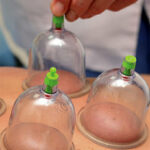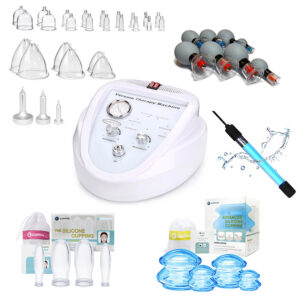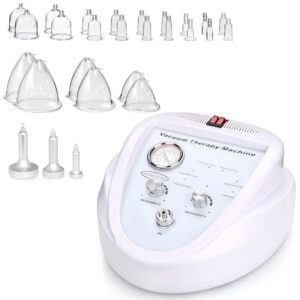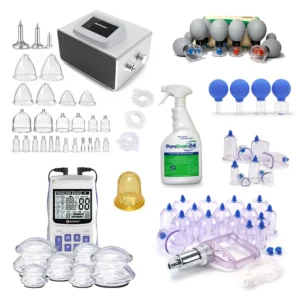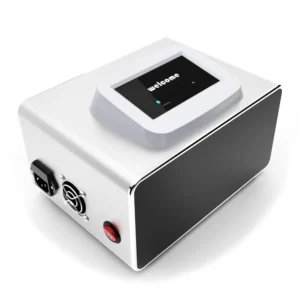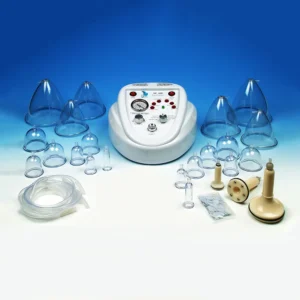Your cart is currently empty!
Vacuum Therapies for Pain Relief
By Anita J. Shannon, LMBT and Rita Woods, LMT
Originally published in Massage Magazine, August, 2013.
Pain is the most consistent complaint brought to professional health care practitioners. To effectively deal with the wide variety of pain conditions, the true cause of the pain must be located and addressed. Pain medications have a great use during a recovery period or extreme cycles of a chronic disorder, yet many people find that long-term use does little more than manage the issue, and can produce other adverse effects.
Vacuum therapies are used to identify and assist the body with releasing the history in the tissue, along with the resulting compensatory patterns that create stress and pain. The most incredible aspect of these techniques is that the condition can be old or new, chronic or acute … and the results can often be apparent immediately. Pain is so often the result of inflammation in the tissues, and techniques using a vacuum tool are very effective in creating vasodilation to provide a vehicle for the inflammation to move to the skin surface for elimination. If the area is an old injury, moving long-standing congestion out of the area will assist with elimination of chronic inflammation as well as restriction of movement.
Restriction of movement may be caused by old debris and also by tissue restrictions such as scar tissue or fascial adhesions, and can have consequences of pain in other areas of the body. The vacuum works so well to identify the restriction and its pathway, and gentle gliding movements are used to gently soften and peel tissue layers apart and free them to move more efficiently.
Consider the client who was referred to us for chronic low back pain. The intake and physicians records did not contain anything unusual, yet in the first treatment, the tissue in the cup revealed serious adhesions in the lower back, including evidence of an epidural injection. Upon inquiry, she revealed that the birth of one of her children included heavy back labor and ended with a cesarean section procedure. The back issues had started a year or so after the birth, which she thought came from lifting the child. This information led to an examination of the entire abdominal area using the large cup and it showed an extreme restriction from the c-section scar that had pulled pubis symphysis forward, contributing to the low back issues.
By using the vacuum tools to release the rigid scar tissue in the anterior of the body, the lower back was able to relax and assume its normal lordotic curve, alleviating pressure on all of the lower back soft tissue and structures. The series of 10 treatments began with focus on the cause of the problem and continued on to include treatment of compensatory issues that had begun in the shoulders, upper back and neck, as well as hips, knees and feet.
The key to working with pain issues is assessment combined with observation, since each cause is unique. A comprehensive intake form along with documentation and diagnosis from the referring physician or other health care practitioner can provide invaluable information, while keen observation, sound evaluation criteria, and plain old experience will create a way of critical thinking that produces amazing results. Each new client case in our VacuTherapies clinic is subjected to the simple six-part evaluation and tracking criteria system that we developed from many years of experience with creating techniques and protocols using vacuum therapies.
Our clinic begins each day with retrieving patient referrals via faxes and emails from local physicians, chiropractors and physical therapy facilities. This networking system continues to grow and we get to view X-rays and patient files, which is so advantageous in providing safe and effective treatment for each of our new clients.
This work still stands apart from current medical practices due to the unique evaluation and tracking criteria, and this allows us to integrate with the medical community while avoiding falling prey to using generic protocols in our work. We are successful working within the existing medical system as a viable CAM modality by providing a protocol that is unique to each individual, producing results that cannot be ignored.
The techniques are so gentle that the clinic staff ventures out to local geriatric facilities twice each week to work with the substantial number of pain issues our elders face, and provide treatments that have produced significant relief and the opportunity for increased life activity.
These pain relief techniques can be used on a wide range of people; infants to elderly, athletes to those with physical challenges, and almost everyone in between. Contra-indications are the same as those for massage, with a few extra cautions regarding work with the micro-cup magnets on clients with any computerized implants or steel internal support appliances. After-care instructions include adequate hydration, rest and avoidance of extreme temperatures for up to 6-12 hours.
According to a recent Institute of Medicine Report: Relieving Pain in America: A Blueprint for Transforming Prevention, Care, Education, and Research, pain is a significant public health problem that costs society at least $560-$635 billion annually, an amount equal to about $2,000.00 for everyone living in the U.S.
The study of pain is a complex and ever evolving science. Each day reveals new insights about receptors, cellular mechanisms, pathways and the neurophysiology involved in acute and chronic pain. The basic mechanics of pain involve the concepts of transduction, transmission, modulation, and perception. Transduction is the process by which afferent nerve endings participate in translating noxious stimuli, such as a pinprick, into nociceptive (nerve) impulses. These impulses are sent to the dorsal horn of the spinal cord, and then along the sensory tracts where they are modulated as they travel a series of descending or ascending pathways. Finally comes perception, which refers to the subjective experience of pain that result from these processes and the psychological aspects of the individual.
The International Association for the Study of Pain (IASP) defines pain as: An unpleasant sensory and emotional experience associated with actual or potential tissue damage, or described in terms of such damage. This is not intended on being a primer on pain but rather a presentation of a theory of pain and possible explanation on how the vacuum therapy can and does effectively relieve pain. Our experience with the cups has shown us that we can effectively reduce or alleviate both acute and chronic pain.
In research aimed at differentiating chronic from acute pain, a phenomenon was discovered that is known as hyperalgesic priming. Simply stated, this means that an injury or insult to tissue can be ‘primed’ by inflammatory mediators causing a recurrence of the pain months or even years later. This creates a hyper-excitability or hypersensitivity within the field of certain nerve fibers resulting in that perception of pain. Often, this pain is greater than that experienced during the original injury. In some instances, the primary afferent nociceptors that were involved in the original painful event trigger a cascade of neurochemical events that can cause a central nervous system change (central sensitization) which in turn, can result in a sympathetically maintained generalized pain syndrome. In some instances this becomes a perpetual cycle where the resultant neurochemistry actually triggers the cycle to begin again.
At the heart of this pain is inflammation. Not just the kind of inflammation you see with an acute injury causing redness and swelling. This consists of cellular protein changes that affect intracellular fluids and extra-cellular space in ways that we are only beginning to understand.
With vacuum therapy, we not only move soft and connective tissue, we move fluids and flush areas of the body. Is vacuum therapy effective at reducing pain and inflammation because we are able to remove these inflammatory mediators away from a localized region, thus preventing immediate and reactivation of a painful event? Our anecdotal information would support this is true but the research is still not available to substantiate a purely scientific claim. But then, the benefits of massage were not scientifically substantiated until many years after our ‘knowing’ that it worked.
As you can see, neurochemistry is intricately involved with pain. One of the wonderful effects of vacuum therapies is nervous system sedation. And we need to remember, not all pain is purely physical! Many common conditions such as insomnia, auto-immune disorders, and PTSD benefit from nervous system sedation. Add that benefit to relief of chronic inflammation and sensitive solid bloat/congestion, and you have a truly effective approach to relief from conditions such as Diabetes, Fibromyalgia and MS.
Can we take the client to a place where overloaded body systems can re-set until triggered again, and will the triggers have less effect if the body chemistry and physiology has shifted due to nervous system adjustment and elimination of old inflammation, debris and restrictions? If the history of the client still stored in the body in neurochemicals trapped within congestion and restrictions … what implications does this have for psychological issues in general? If the old neurochemical triggers are eliminated, could the cells and nervous system have a chance to move towards homeostasis? The micro-cup magnets are also an invaluable tool for the treatment of pain. The negative polarity is used to assist the tissue with moving from the injured state to the recovery state, and this can apply to acute and chronic pain. Many injuries and surgeries impacted the body and the tissue never had a chance to recover. The area is still in a state of acid hypoxia with a positive charge, and using the negative polarity magnet enables the area to shift to a healthier PH and release the ramifications of the injury.
The negative magnet cools and sedates, while the positive polarity magnet stimulates and is used to deal with issues of pain by stimulating the production of neurochemicals such as enkephalins and endorphins. This combination creates tissue that is so responsive to vacuum therapies, and is especially powerful for neuropathies resulting from Diabetes, MS, sciatica and other nerve compression and Bell’s palsy. The blue magnet may be used alone, yet the red magnet must always have the blue present to balance the actions.
Vacuum therapies can also be combined with other modalities, such as lymphatic and soft tissue taping, or products such as essential oils and topical analgesics, to produce increased results. This synergistic approach is so complete and can even be enhanced with safe home care vacuum tools, when applicable.
Learning and practicing VacuTherapies opens the door to viewing and treating clients with pain issues in a new way, and provides a supremely viable means of interacting with the medical field. These are tools and techniques for the “thinking therapist”. In all honesty, there is no single definition for the burning sensations, colors that arise in the skin, odors, or many other of the indicators that will show up during a session. The burning could mean anything from the release of a scar or fascial adhesion to a high level of lymphatic congestion.
This is where experience and a questioning mind come into play for each person on whom you use these tools and techniques. Thoroughly learn and practice vacuum therapies while observing the results carefully. Keep photographic records and use the evaluation and tracking criteria to measure progress, and then protocol development will become much easier for you. Each client is observed and evaluated separately, as they each are individuals who bring a lifetime of living to your massage table; no two client presentations will be exactly alike. You can only develop this kind of evaluation with time, observation and experience, and the opportunity to further refine this work never ends.

Educator Info
- LMBT, CMCE
- ACE Founder
- Director of ACE
- Massage Therapy Hall of Fame Inductee – 2011
Contact
- Email: info@massagecupping.com
- Facebook: Facebook.com/ACEMassageCupping
- Website: MassageCupping.com
Anita J. Shannon has been a licensed massage therapist and licensed cosmetologist since 1983. She specializes in skin care, body treatments, clinical aromatherapy, and various modalities of massage therapy. She has been a national educator since 1990, appearing at numerous national spa and massage conventions each year. For four years, Anita appeared as a co-host on the television program “Health Options Today” with Dr. Mitchell Ghen.
Anita is the founder and director of Advanced Continuing Education (ACE), an NCBTMB CE provider established in 2001. Anita has presented hundreds of workshops on ACE Massage Cupping and MediCupping therapy throughout the US and internationally since 2002. Anita has been published on the subject of cupping therapy in industry publications such as Massage Today, Massage Magazine, and Les Nouvelles Esthetiques. She has published two educational videos on ACE Massage Cupping bodywork, two on MediCupping therapy and one on TheraCupping home care, and is currently writing a book on VacuTherapies. In 2011, Anita was inducted into the Massage Therapy Hall of Fame.
In 2016, Anita opened ACE Institute Online, an online education portal designed to bring cupping therapy training into the digital age. Since its debut in 2016, ACE Institute Online has introduced the revolutionary techniques found in ACE Massage Cupping and MediCupping to over ten thousand students worldwide.
Anita’s Upcoming Workshops

Educator Info
- LMT, CMCE
- Joined ACE in 2017
Education:
Bachelors of Science from Southern Illinois University in Workforce Education and Development with a specialty in vocational training and education.
Associates of Science from Florida State College in Medical Laboratory Technology.
Diploma in Massage Therapy from the Mandarin School of Chinese Medicine, Jacksonville, FL.
Work History:
Private Practice Medical Massage 2004-present.
I worked in my own office from 2004-2013 in Dahlonega, GA. In 2013 I moved to Asheville, NC and started working as an independent contractor at Hawk Ridge Therapeutic where I have successfully performed over 12,000 massages.
I received my certification as a Complete Decongestive Therapist (CDT) also known as a lymphedema therapist, from the Norton School of Lymphedema through a Duke University continuing education program.
I also specialize in vacutherapy, myofascial release and am a certified kinesiology taper. A large part of my practice clientele is physician referred.
Writer, Educator and Speaker:
I was a columnist for Massage Today Magazine from 2008-2012 and was the chief pathophysiology researcher for the textbook, Step by Step Massage Therapy Protocols for Common Conditions published by Lippincott in 2011. McGraw Hill Publishers hired me to peer review a national massage therapy study guide in 2007.
As a continuing education instructor at Florida State College, I served on the Deans Committee for new program development. I created the massage therapy program at Florida State College in Jacksonville, FL from conception to final approval by the State Board of Education. I was the only bodyworker invited to speak at the American Academy of Anti-Aging Medicine in Las Vegas in 2005.
My company, Darien Lourde, Inc was a continuing education provider for massage from 2002-2012 which included 2 instructors who provided continuing education for Massage Envy in Arizona. Each year I continue to travel and teach through the massage therapy program at John A Logan College in Carterville, IL. I teach a variety of continuing education courses there including kinesiology taping, Vacutherapy, reflexology, medical massage and the Rejuvenating Facelift Massage technique.
In addition to my medical and massage experience, I taught emergency preparedness and basic firearms at the University of North Georgia from 2009-2012. This university was also known as the Military College of Georgia
Special Talents:
I have the ability to transform complicated information into a presentable format that is understood by the general population. My teaching skills are superb. I have a passion for presenting information that is useful and practical.
Military History:
As a Naval Reservist from 1985 through 1993, I served in the medical corp including managing a blood bank in a 500 bed fleet hospital in the Middle East during Operation Desert Shield and Desert Storm. I am a combat veteran and have received numerous medals and awards throughout my military career.
Rita’s Upcoming Workshops
Latest Articles by Rita Woods
What Vacuum Therapy Equipment Do I Need to Get Started with MediCupping?
ACE offers a number of vacuum therapy machines that are suitable for any skill level ranging from beginner to expert. ACE MediCupping vacuum therapy machines include all of the cups, hoses, and basic accessories that you’ll need to begin learning and performing MediCupping vacuum therapy. Each machine also includes a comprehensive, intro-level MediCupping online course that introduces students to MediCupping concepts, equipment, and techniques. In addition, all vacuum therapy machines we sell include a 1 year warranty from the date of delivery.

